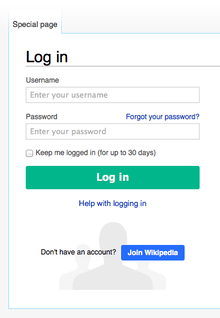Login

In computer security, a login or logon or sign in refers to the credentials required to obtain access to a computer system or other restricted area.[1][2] Logging in or on and signing in or on is the process by which individual access to a computer system is controlled by identifying and authenticating the user through the credentials presented by the user.[2]
Once a user has logged in, they can then log out or log off or sign out when access is no longer needed. To log out is to close off one's access to a computer system after having previously logged in.
Procedure

Logging in is usually used to enter a specific page, which trespassers cannot see. Once the user is logged in, the login token may be used to track what actions the user has taken while connected to the site. Logging out may be performed explicitly by the user taking some actions, such as entering the appropriate command, or clicking a website link labelled as such. It can also be done implicitly, such as by the user powering off his or her workstation, closing a web browser window, leaving a website, or not refreshing a webpage within a defined period.
In the case of web sites that use cookies to track sessions, when the user logs out, session-only cookies from that site will usually be deleted from the user's computer. In addition, the server invalidates any associations with the session, making any session-handle in the user's cookie store useless. This feature comes in handy if the user is using a public computer or a computer that is using a public wireless connection. As a security precaution, one should not rely on implicit means of logging out of a system, especially not on a public computer, instead one should explicitly log out and wait for the confirmation that this request has taken place.
Logging out of a computer when leaving it is a common security practice, preventing unauthorized users from tampering with it. There are also people who choose to have a password-protected screensaver set to activate after some period of inactivity, requiring the user to re-enter his or her login credentials to unlock the screensaver and gain access to the system. There can be different methods of logging in that may be via image, fingerprints, eye scan, password (oral or textual input), etc.
Etymology
The noun login comes from the verb (to) log in, which was formed by analogy with the verb to clock in. The expressions may also have a more literal origin — computer systems tend to keep a record, called a log, of users' access to the system; hence, to log in is to prompt an entry into the system's log by accessing the system. Signing in connotes the same idea, in that providing the credential that authenticates a user's right to entry is akin to a signature.
The terms began to enter common usage among computer users with the origin of the computer Bulletin Board System (BBS) in the 1970s.
See also
| Look up login in Wiktionary, the free dictionary. |
| Look up log in in Wiktionary, the free dictionary. |
| Wikimedia Commons has media related to Login screens. |
- Account
- Computer security
- Login session
- Login spoofing
- OpenID
- Password
- Password policy
- Personal identification number
- /var/log/wtmp
References
- ↑ Oxford Dictionaries, definition of login.
- ↑ 2.0 2.1 The Linux Information Project, detail and definition of login and logging in.